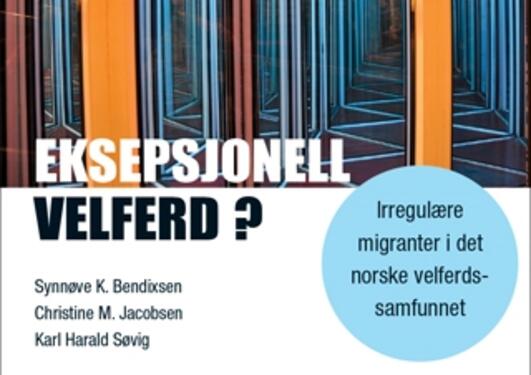7 short reflections on interdisciplinarity
In this blog post, anthropologist at the University of Bergen (UiB), Christine M. Jacobsen, reflects on interdisciplinarity across law and anthropology in migration studies.

Main content
Jacobsen has worked with legal scholars and with questions pertaining to law, anthropology and migration in several different projects and research constellations, such as WAIT (Waiting for an uncertain future: the temporalities of irregular migration); PROVIR (Provision of Welfare to Irregular Migrants); Native/Immigrant/Refugee; and PROTECT (The Right to International Protection. A Pendulum between Globalization and Nativization?).
Drawing on her broad experience with the pleasures and challenges of interdisciplinary work, she presents seven reflections on interdisciplinarity. Her reflections highlight the role of positionality, foreground the necessary work of self-reflexivity and translation, and fruitfully suggests how interdisciplinarity might be thought in terms of a space of encounters.
1. There is nothing straightforward about interdisciplinarity
A first thing to note is that despite how ubiquitous the term is, there is nothing straightforward about interdisciplinarity. The multitude of prefixes - cross, multi, inter, trans and post - although used in partly overlapping ways, signal different understandings of, and expectations towards collaboration, and rely on different methodological, epistemological and ontological assumptions. One important difference is the way in which they relate to disciplines, from a firm grounding within them to transgressive challenges to the limitations imposed by disciplines – or the disciplining of knowledge. Interdisciplinarity is about more than method, though. It involves epistemological questions about how truth is formed - how disciplines see and evaluate phenomena. There are also ontological stakes, involving questions of the constitution of objects and phenomena we research.
2. Interdisciplinarity is positioned
A further thing to note is that interdisciplinarity is not just about bringing together disciplines on somehow ‘neutral’ ground and make them work together. In doing interdisciplinary research, we are always positioned in complex structures of power-knowledge. A good place to start reflections is with our own positionality in disciplinary terrains. To take myself as an example, my scholarly work is in anthropology, migration studies and gender studies, which each have different understandings of, and practices of interdisciplinarity. Anthropology is arguably itself interdisciplinary, covering knowledge areas from the humanities, social sciences, and natural sciences within its disciplinary identity (with subfields such as social and cultural anthropology, physical, linguistic, and legal anthropology). Migration studies, on the other hand, is interdisciplinary perhaps primarily in the sense that migration as an object of research, or a societal challenge, has economic, political, legal, social, cultural, religious, demographic, climatic, and more dimensions that need to be addressed. In contrast, gender studies scholars often speak of trans- or even post-disciplinarity, approach disciplinarity with a critical gaze, and encourage knowledge production across and outside of disciplines for instance by including activists, muted groups, and subaltern subjects in knowledge production.
3. Differences are not just between but also within.
Our positionality shapes the expectations we have when we enter interdisciplinary work.
But there are differences not just between disciplines, but also within and across them.
The biggest difference to me as an anthropologist has been whether the legal scholars whom I cooperate with are trained in doctrinal legal studies or in critical legal studies and the law and society tradition. In the Native/Immigrant/Refugee project, we cooperate with legal scholars from the Centre for Gender and Race at Berkeley, which is an interdisciplinary centre with a long tradition for working across the social sciences and the humanities. We share a set of theoretical and conceptual orientations from critical interdisciplinary migration and gender studies. In PROVIR (Provision of Welfare to Irregular Migrants), the first project bringing together legal scholars and anthropologists at UiB around the question of irregular migration, on the other hand, we had to start the interdisciplinary work much more from scratch. We did not start with a clear understanding of what kind of interdisciplinarity we were aiming for, neither what we expected from it, or its potential challenges. The meta-reflection on interdisciplinarity was an outcome of rather than a starting point for our work.
4. Interdisciplinarity as “throwntogetherness”
What then are the takeaways from the experiences I had with co-operation between anthropologists and legal scholars in migration studies at UiB? First, I want to stress the importance of creating a space of encounter and being open to the multiplicity of trajectories within it. One way to think of such interdisciplinary spaces of encounter, I suggest, is in terms of Doreen Massey’s concept of throwntogetherness. To Massey, throwntogetherness is one of the truly productive characteristics of material spatiality. It involves ‘the potential for the happenstance juxtaposition of previously unrelated trajectories, the business of walking around a corner and bumping into alterity, of having (somehow, and well or badly) to get on with neighbours who have got ‘here’ … by different routes from you; your being here together is, in that sense, quite uncoordinated. This is an aspect of the productiveness of spatiality which may enable ‘something new’ to happen.’ (Massey, 2005: 94). This understanding of interdisciplinarity as throwntogetherness is arguably informed by my epistemological grounding in anthropology, which sees knowledge as produced in the encounter with ‘the other’. Being thrown together, encountering the disciplinary other, also means being confronted, challenged, and unlearning. Avoiding oversimplification and reductionism of other and self is important.
5. Self-reflexivity and translations
Being thrown together in interdisciplinary work may stimulate consciousness of and reflexions on positionality and foundational assumptions. Communicating these foundational assumptions to others and accepting disagreement is a continuous challenge however and may involve complex acts of translation. One example is when a legal scholar I was co-operating with used theology as an analogy to explain to me how legal scholars work. Given that I have spent quite some time studying religion and in particular Islam as a discursive tradition (Jacobsen 2011), this resonated with me in a different way than it may have done with other anthropologists. At the same time, I attempted to translate the ‘guerilla-anthropology’ calls from scholars in my department to radically challenge established ways of thinking in the humanities and social sciences. One of the main challenges we faced in our interdisciplinary collaboration around the question of irregular migration was precisely how to understand authority, and relationships to the state. Should our point of view be from the perspective of the state, or from the perspective of the migrants, and was law protecting irregular migrants or the source of their violent exclusion?
6. Collaborative practices that work towards interdisciplinarity
In the projects I have been involved in, gathering legal scholars and anthropologists, we have tried out some hands-on methods for enhancing interdisciplinary understanding, including: 1) Reading texts together; 2) Involving people who read across and can serve as mediators and translators; 3) Training young scholars within an interdisciplinary research environment, e.g., through co-supervising; 4) Developing concepts and writing together; and 5) Discussing concrete ethnographic cases. Ethnographers in the field of migration studies participate in contexts where law is put into practice and interpreted. In the field, we interact with migration and asylum lawyers and follow cases as they go through the legal system. Here, we get insight into what law entails ‘in practice’. Legal scholars often find this interesting, as empirical evidence of how for instance laws may fail to protect those they intend to protect and how they may have adverse effects that are not intended in the law. Examining the relationship between legal framework and how it is put into practice can be a productive task for interdisciplinary work between anthropologists and legal scholars, but we should avoid reifying it as a main division of labour. There is, I believe, a much larger potential for developing new concepts and approaches. Adrian Favell (2007) suggested years ago in critiquing methodological nationalism in migration studies that, ‘developing a post disciplinary view [in migration studies] may well help scholars think, for once, outside of the box’ and to ‘recast the subject of migration in a thoroughly decentered, global perspective.’
7. Being disciplined in an inter/disciplinary system
This said, there are a number of conundrums and opposing forces that shape the conditions of possibility for multi, inter, trans and post disciplinary research on migration. One is the workings of the funding system, which increasingly ‘pushes’ researchers towards interdisciplinarity. This sometimes ends up as little more than window-dressing and may prevent creativity and in-depth development of concepts and approaches from within the disciplines. Furthermore, the financial structure still sits uneasily with the merit structure within universities, were disciplinarity to a large extent governs for instance hiring practices in departments, publishing regimes etc. Importantly, those doing PhDs in interdisciplinary projects are incessantly reminded that their thesis is to be defended and assessed within a discipline. Finally, doing interdisciplinary work is extremely time consuming, a time that remains largely uncounted and unrecognized both by funders and universities. If we want to be ambitious about interdisciplinary research involving legal scholars, anthropologists and many more in addressing contemporary societal challenges related to migration and renewing our conceptual tools beyond disciplinary constraints, we need to create and institutionally support spaces of encounter in which a multiplicity of trajectories are allowed to develop over time.
References
Favell, Adrian. 2007. Rebooting migration theory: Interdisciplinarity, globality and postdisciplinarity in migration studies. In Brettell Caroline, Hollifield James. Migration Theory: Talking Across Disciplines (2nd ed.), Routledge, pp.259-278.
Jacobsen, Christine M. 2011. Islamic traditions and Muslim youth in Norway. Leiden: Brill.
Massey, Doreen. 2005. For Space. London: Sage




